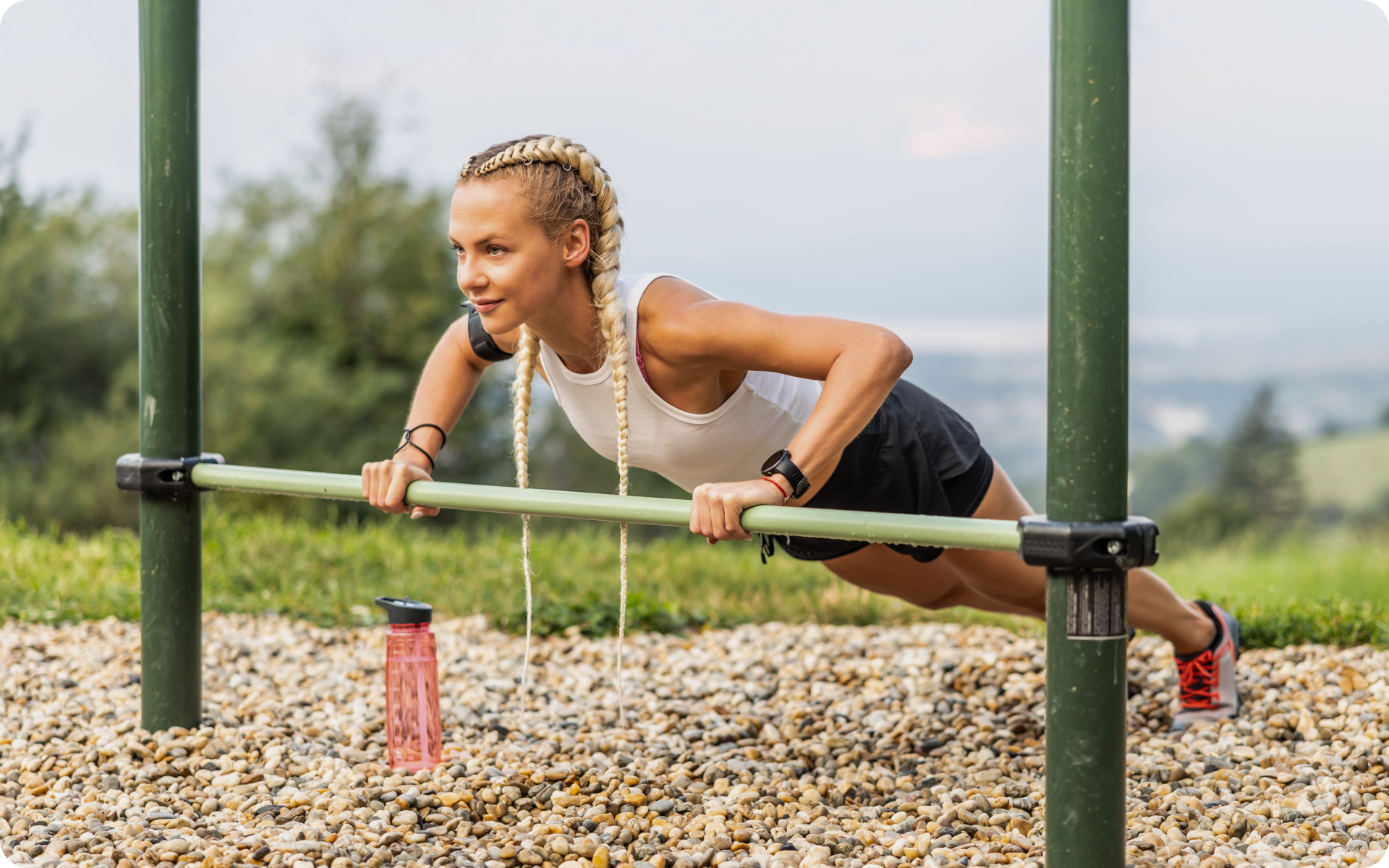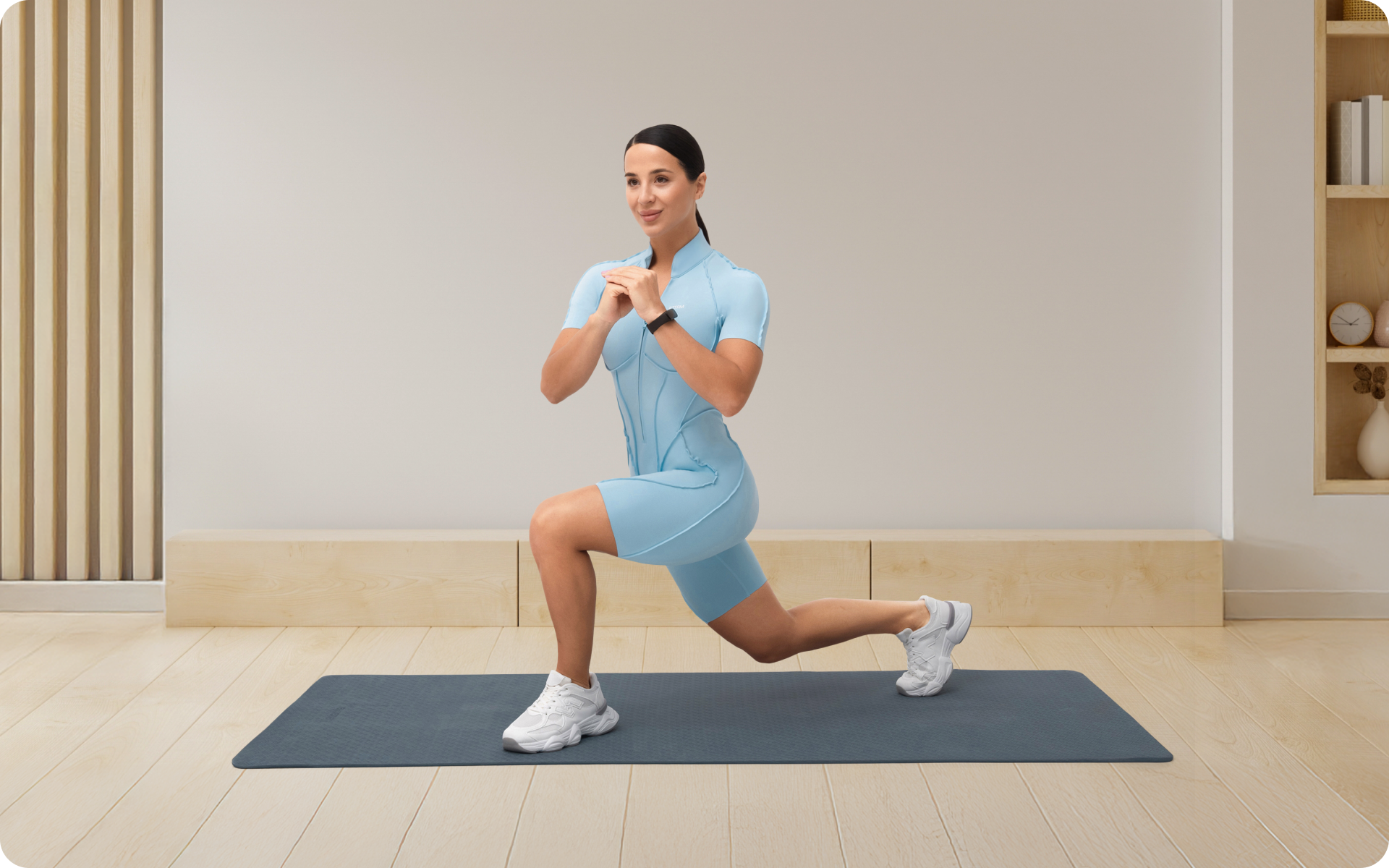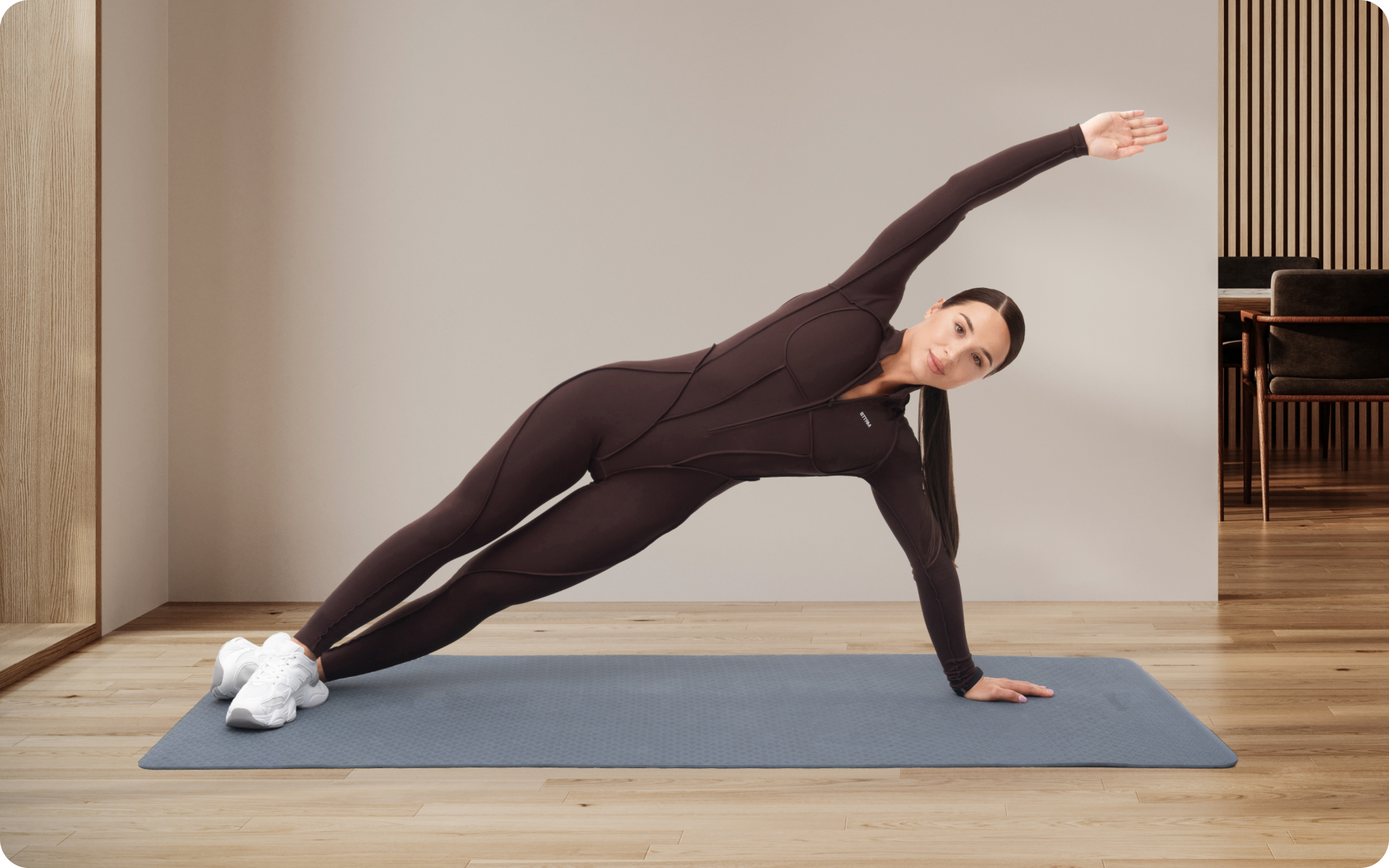For those looking to workout either for weight loss, weight maintenance, or simply as a way to improve their health – but do not want to go to the gym – calisthenics could be the best choice.
The popularity of calisthenics workouts is growing at a steady rate as people realize the many benefits associated with this kind of workout routine. Not only does it not require any expensive equipment, but it is great for improving functional fitness and has all of the health benefits similar to other kinds of exercises.
If you are interested in trying out this workout, but you do not know where to start, you are in the right place. In this intro to calisthenics, we will be going through the best calisthenics for beginners, list the best beginner calisthenic moves/exercises, explain the best duration for a workout session, and much more.
What Are Calisthenics
Before getting into the best calisthenics for beginners (no equipment), we must first understand what constitutes this type of workout.
For those unfamiliar with calisthenics, these are exercises that you perform with your own bodyweight with zero added resistance from gym machinery or free weights.
Not only does this make them one of the cheapest exercises to engage in, but research has also shown that regardless of the lack of weights, these workouts have incredible benefits. Some of these benefits include (6, 8, 2, 5)
- Improved flexibility
- Increased muscle strength, mass and endurance
- Improved cardiovascular health
- Improved balance and coordination
- Improved mental health
- Weight loss and prevention of metabolic disease
Yanking yourself back in shape has never been so easy with our game-changing fitness app! Start transforming your life with BetterMe!
How Do Beginners Start Calisthenics?
Because calisthenics only requires your body weight and some space to do them, they are pretty easy to start. However, as a true beginner, especially to working out as a whole, this too can be confusing.
According to Self Magazine the best thing to do in this case is to master the seven foundational movement patterns of any fully rounded calisthenics plan. These movement patterns include squat, lunge, plank, hinge, rotate, push, and pull are not only the basis of many strength training exercises, but they are also an integral part of everyday life which make calisthenics a functional workout routine.
A calisthenic workout with no equipment that incorporates the above patterns would include the following simple exercises:
1. Squat – Basic Bodyweight Squat
In fitness, bodyweight squat are praised for being one of the best lower body exercises. They not only grow your glutes but can also help slim and tone your thighs which makes your legs look amazing.
As a functional exercise however, doing squats comes in handy in real life as you use these same muscles to climb stairs, walk, bend over, lift heavy things off the ground, sit down, etc.
How to do a basic squat
- Start standing with feet hip-distance apart, toes pointed out slightly, and arms at sides.
- Keeping the torso upright, bring your hands up and clasp them together at chest level.
- On an inhale, engage core and glutes, shift hips back and down, and bend at knees to lower your bum until thighs are at least parallel with the floor.
- Exhale and press into heels and mid-foot to straighten legs and return to standing position. Be sure to raise your hips and torso at the same time, i.e do not raise the butt/hips first. Then raise and lower arms back to sides.
Read more: The Simplest Lower Back Calisthenics Guide for Beginners
2. Lunge – Basic Front Lunges
Lunges are essential in any calisthenics exercises list. As a resistance exercise, lunges help strengthen your back, hips, and leg muscles. As a functional exercise, they improve mobility, stability, balance, strength, and also help you in everyday life in activities like running, walking, and climbing stairs.
How to do simple forward lunges:
- Stand tall with your feet hip-width apart and your arms by your sides.
- Brace your core and bring your hands to your hips. Take one large step forward with your right leg and make sure it lands flat and remains flat on the floor. Think of it as taking a large walking stride. Keep the left leg behind and the heel should raise slightly off the ground. As you bend both knees and lower yourself to the floor till they form a 90-degree angle.
- Make sure that you continue to breath, keep the torso upright and core engaged throughout the exercise.
- Press through the front right leg and push yourself off the floor into the standing starting position.
- Switch your legs and repeat the movement.
3. Plank – Elbow Plank
There are many plank variations, however, the elbow plank is the easiest, especially for beginners. Planks are full-body exercises that help with core strength and also contribute to calorie burning, which helps with weight loss and maintenance.
As mentioned above, they are exceptional for core strengthening. Remember that a strong core makes everyday activities such as bending, lifting and carrying, twisting, reaching overhead — even vacuuming, hammering, mopping, and dusting that much easier.
How to do an elbow plank:
- Get into the plank position by lying on the floor face down with your forearms and toes on the floor. Your elbows should be directly under your shoulders and your forearms pointing forward. Your gaze should be at the floor and head and neck relaxed.
- Engage your core, lift your hips off the ground and keep the torso straight from the head to the toes. Do not arch your back or sag in the middle bringing your belly to the floor.
- Hold this position for 20 to 30 seconds.
4. Hinge exercises
These are exercises where you bend forward with the major joint motion being at the hip. Good examples of hinge workouts include deadlifts, hip thrusts, good mornings, and kettlebell swings among others.
How to do banded deadlifts. Calisthenics do not use weights so using a barbell, kettlebell, or dumbbell for deadlifts will not work. However, a resistance band is allowed and can be used to modify and do this exercise:
- Start by placing a long resistance band on the floor in a straight line.
- Step forward and step on the band right in the middle. Move the feet apart to make sure that you are standing with your feet flat on the floor and the feet hip-width apart.
- Bend over and hold each end of the band in your hands. Remember that the nearer your hands are to your feet, the higher the resistance will be as you stand up.
- Bending slightly at the knee, engage the core, keep the back flat, and stand up in a slow and controlled manner without letting go of the band, focusing on hinging and pressing the hips forward to stand up.
- If the band is long/stretchy enough, you should be able to stand all the way up. This counts as one rep.
- Bend over again by pushing hips backward to starting position and begin another rep.
5. Rotate/Rotational Exercises
These exercises use the core, spine, and a bit of the hips in their movements. Rotational exercises make for a strong core and torso which is essential for real-life movements and mobility, posture, as well as coordination.
Some examples of rotational calisthenics for beginners include Russian twists, rotational lunges, windshield wipers, hanging knee circles, bicycle crunches, etc. if you are looking for lower back calisthenics exercises, these exercises fit the bill perfectly as they also work your lower back and spine.
How to do windshield wipers:
- Lie face-up on an exercise mat with your arms by your sides and your palms facing down. Make sure that both the spine and pelvis are in a neutral position.
- Engage your core and lift your feet off the ground to bring your knees toward your chest. You can keep the knees bent or choose to straighten the legs.
- Slowly and in a controlled manner, lower your legs to the right side of your body. Stop right before the legs touch the floor.
- Hold here for 2 seconds then with the core muscles still engaged, rotate your legs back to the middle starting position.
- Rotate the hips and legs to the opposite side and repeat for the desired number of reps until the set is complete.
6. Push Exercises – Pushups
Like the name suggests, these are upper body exercises that work the muscles used in the pushing motion/movement. The muscles worked using these exercises include the chest, shoulders, deltoids, triceps, and more.
Like planks, push-ups come in multiple variations. However, for beginners, the knee push-up is the best place to start
- Get into a plank position with hands and toes in contact with the floor. Then drop knees to the floor gently and make sure your hands are slightly wider than your shoulders.
- Engage your core and lower your torso until your chest comes within 1-2 inches of the floor. Pause here for a few seconds.
- Slowly and steadily push your torso back to start position and straighten your arms. This is one rep.
7. Pull Exercises – Pull Ups
These are the opposite of push exercises and they work the muscles used in the pulling motion/movement including your back muscles and biceps. Like deadlifts, they require equipment and a pull-up bar is perfect for this.
- Stand directly under the bar and lift your hands to grab the bar in an overhand grip. Move your hands apart till they are slightly further than shoulder-width apart.
- On an exhale, engage your core, keep the shoulders back and down, bend your elbows, and then raise your upper body up toward the bar until your chin is over the bar. Be sure that you aren’t swinging your legs around or shrugging your shoulders up – this helps you keep proper form.
- Hold this position for a few seconds then on an inhale, extend your elbows thus lowering your body back down to the starting position.
All the above exercises make for a good calisthenics for beginners at home routine. If you take all the seven exercises and do each for 3 sets of 10 to 12 reps, you will be able to get a good full-body calisthenic workout in less than an hour.
If you wish to cinch your waist, tone up your bat wings, blast away the muffin top – our fitness app was created to cater to all your needs! BetterMe won’t give excess weight a chance!
How Long Should A Beginner Calisthenics Workout Be?
According to the Centres for Disease Control and Prevention, adults should have 150 minutes of physical activity each week. This translates to 30 minutes of exercise 5 days a week (3).
Using this guideline from the CDC we can say that for beginners your calisthenics workout routine should last about 30 minutes.
Please note that warm-up and cool-down are essential for any workout thus adding 5 minutes of warm-up and cool-down (10 minutes total) will go a long way in keeping you fit and reducing muscle pain.
So all in all, your workout should last anywhere between 30 to 40 minutes. Start at your own pace and build up to this amount over time if needed.
How Do I Start Calisthenics From Nothing?
If you have never done calisthenics before, the above-mentioned exercises are the perfect place to start.
Contrary to what you see on social media, calisthenics does not always require complicated and fancy moves. Everyone you see doing all those complex moves was at one time a novice just like you and they worked their way to those expert levels you see.
Aside from these workouts, you will also need the perfect ‘calisthenics starter pack’. This includes the following:
- Workout clothes – Make sure they fit right and are breathable
- The perfect shoes – They should fit well – not too tight or loose and should have good arch support
- Pull-up bar – This is essential for the above-mentioned pull workouts.
- Jump rope – As mentioned above, warm-ups are essential for any good workout plan. Skipping rope is one of the easiest cardio exercises to help get your blood moving and warm up your muscles before getting into the calisthenic workout session.
- Resistance bands – They can be used for multiple exercises like the above-mentioned modified deadlifts. They can also be used for other workouts like bicep curls, seated rows, and abductions and to add resistance to other workouts like push-ups, dips, and squats among others. They can also allow you to reduce the intensity of some exercises, such as being a useful modification for pull-ups.
Is 20 Minutes of Calisthenics Enough?
Generally, 30 minutes of exercise a day is recommended for beginners and they can work their way up from there. However, if 30 minutes is too much for you, starting off at 20 minutes is okay. Anything is better than living a sedentary life.
Such a lifestyle has been linked to the increased risk of cardiovascular disease, cancer, and metabolic disorders such as diabetes mellitus, hypertension, and dyslipidemia; musculoskeletal disorders such as arthralgia and osteoporosis; as well as mental illnesses like depression and cognitive impairment (7).
With that said, while you can start with just 20 minutes a day, increasing the time limit for your calisthenics for beginners routine to 30 minutes or more is recommended. This will go a long way in helping you reach your goals faster and preventing a plateau.
Read more: Calisthenics Shoulder Exercises: Techniques and Workouts
No, it is not. Doing calisthenics or any kind of workout every day is not recommended (1). Failure to rest can lead to overtraining syndrome which presents as unexplained underperformance, excessive fatigue, mood swings, irritability, insomnia, increased risk of injury, loss of appetite, as well as mental health issues like increased anxiety and even depression (4). Not necessarily. Working at the gym or via calisthenics has similar health benefits. Both options will help you control weight gain and improve weight loss, they are good for mental health, will help boost cardiovascular health and will even help with increased muscle growth and mass. However, doing gym workouts, specifically via weight lifting, might produce faster results in terms of muscle mass. Because calisthenics only uses your body weight for resistance, your muscles will not become as big (aka swole). However, because of the added weights using machinery and free weights, such exercises are much better for increased muscle mass – this is perfect for anyone looking to build those big bodybuilder muscles. No, it is not. Calisthenics can be done by anyone regardless of age and fitness levels. If you are a true beginner, that is you have no previous experience with exercise in general, the best skills to learn are those mentioned above. In fact, it is best to find a 30-day calisthenics workout for beginners that utilizes these exercises instead of any fancy movements. As previously stated, these movements are fundamental and are the base for all calisthenics as well as day-to-day movements. Grasping these first gives you a good foundation to build on any complex calisthenics movements that you may wish to do in the future. Yes you can. Some calisthenic back workouts to help with this include push ups, pull ups, wall pulls, inverted rows, muscle ups, chin ups, etc.FAQs
Is It OK To Do Calisthenics Everyday?
Is Calisthenics Better Than Gym?
Is 30 Too Late For Calisthenics?
What Calisthenics Skill Should I Learn First?
Can You Build Your Back With Calisthenics?
The Bottom Line
Calisthenics for beginners is a great place to start for anyone who wishes to not only workout more, but wants to use their body more, pushing it to see what they can accomplish. If you are looking to start, remember to do so slowly so as not to injure yourself.
DISCLAIMER:
This article is intended for general informational purposes only and does not serve to address individual circumstances. It is not a substitute for professional advice or help and should not be relied on for making any kind of decision-making. Any action taken as a direct or indirect result of the information in this article is entirely at your own risk and is your sole responsibility.
BetterMe, its content staff, and its medical advisors accept no responsibility for inaccuracies, errors, misstatements, inconsistencies, or omissions and specifically disclaim any liability, loss or risk, personal, professional or otherwise, which may be incurred as a consequence, directly or indirectly, of the use and/or application of any content.
You should always seek the advice of your physician or other qualified health provider with any questions you may have regarding a medical condition or your specific situation. Never disregard professional medical advice or delay seeking it because of BetterMe content. If you suspect or think you may have a medical emergency, call your doctor.
SOURCES
- 8 Reasons to Take a Rest Day (2018, acefitness.org)
- Effect of Progressive Calisthenic Push-up Training on Muscle Strength and Thickness (2018, journals.lww.com)
- How much physical activity do adults need? (2022, cdc.gov)
- Overtraining Syndrome (2012, ncbi.nlm.nih.gov)
- Protocol for Minute Calisthenics: a randomized controlled study of a daily, habit-based, bodyweight resistance training program (2020, ncbi.nlm.nih.gov)
- Psychological effects of calisthenic exercises on neuroinflammatory and rheumatic diseases (2015, link.springer.com)
- Sedentary Lifestyle: Overview of Updated Evidence of Potential Health Risks (2020, ncbi.nlm.nih.gov)
- The effects of a calisthenics training intervention on posture, strength and body composition (2017, researchgate.net)













